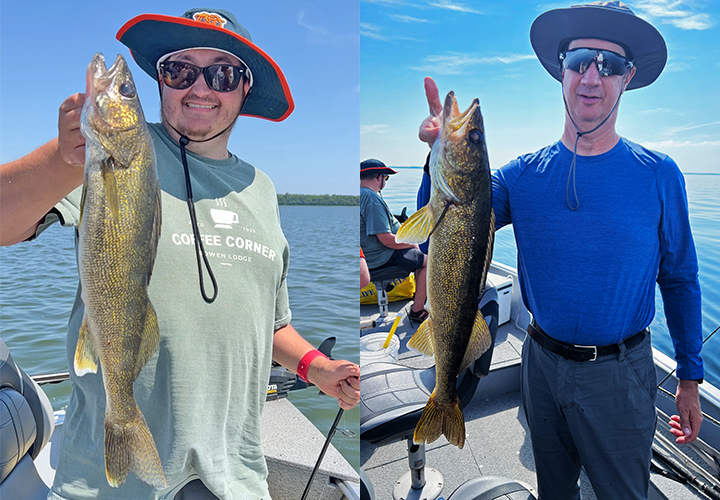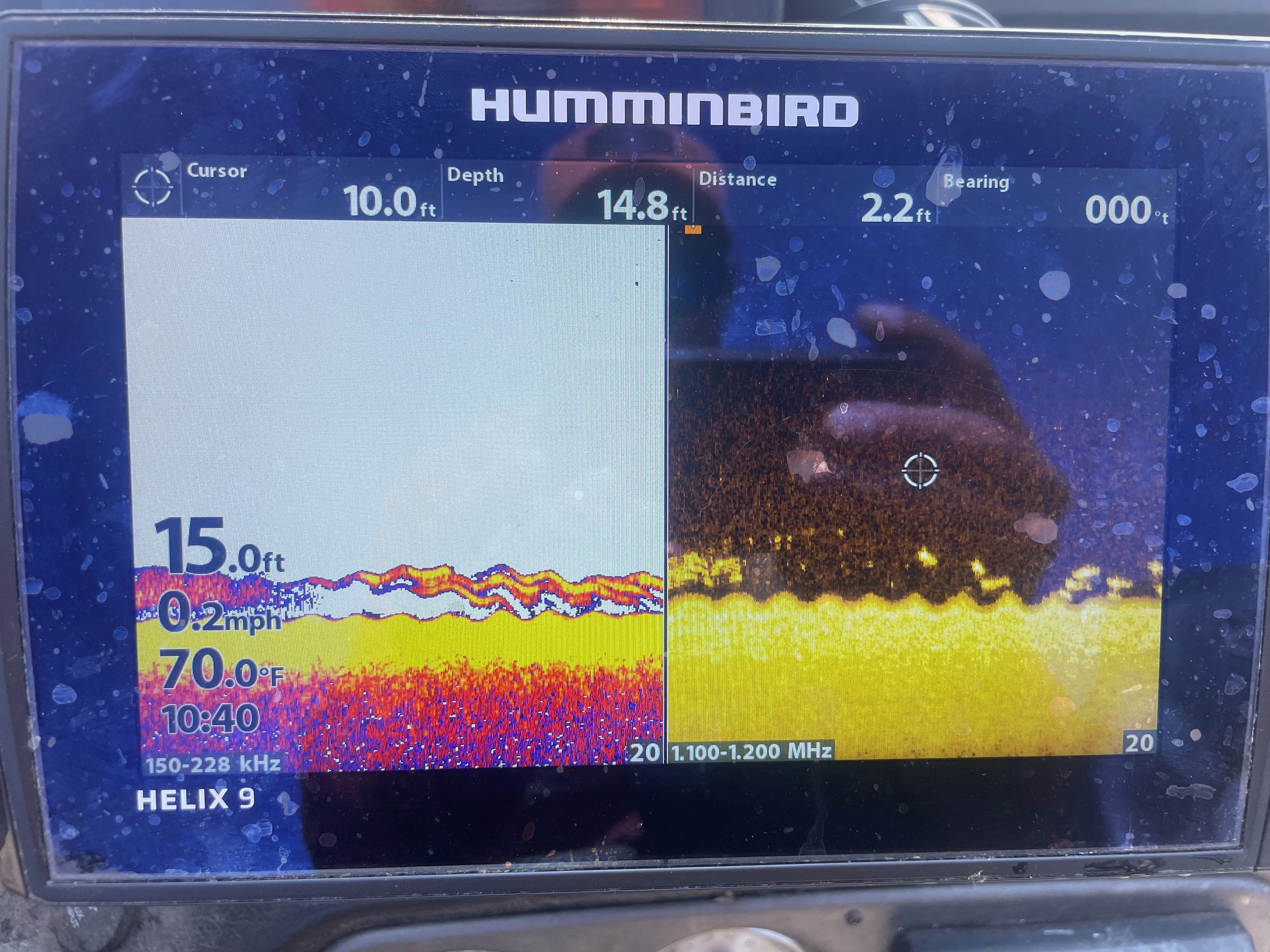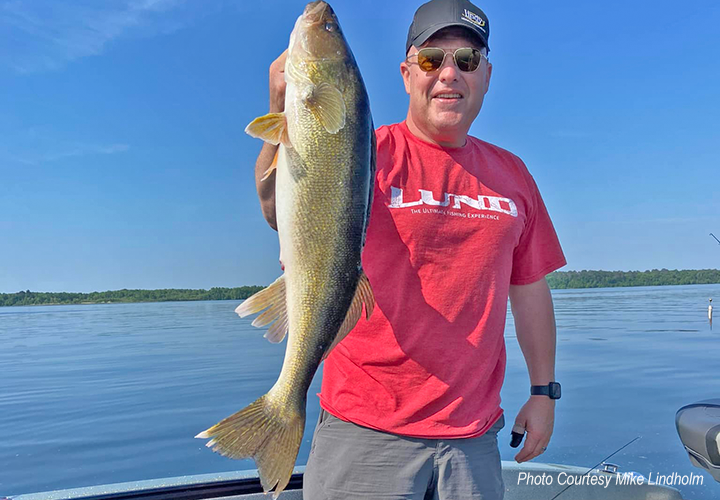On Lake Winnie, water clarity has been in decline since the arrival of this week’s string of warm and calm, sunshiny days. As of Friday, getting a good look at the bottom required moving into water depths of about 6 to 7 feet. That’s still somewhat clear compared to the pre-zebra-mussel times, but a significant improvement for anglers compared to the super-clear conditions we experienced recently.
Aided by the lowered light conditions walleyes, at least some of them, have moved into classic, late summer habitat like shoreline breaks, mid-depth gravel flats and areas of submerged vegetation. Lower light penetration into the water, combined with rising surface temperatures that affect fish behavior, helps explain why our guests were able to catch fish this week using trolling presentations.
Spinners, tipped with live bait, provided action for some of our guests who fished shoreline breaks. Crankbaits trolled over the flats, in 12 to 16 feet of water provided action for folks fishing some of the mid-lake structures on Big Winnie. Cutfoot walleyes responded to jigging raps fished on shoreline points, and some of the mid-lake bars. Our guide, Jared Saufferer, is still catching fish using slip-floats and live bait, but he acknowledged that trolling spinners has worked as well.
Despite the improved conditions, not all the walleyes are on the prowl during the daytime. When the lake goes flat calm, the action grinds to a halt. On Thursday, our guests Ben, Jake, and Paul were on the lake with one of the local guides. The morning was calm and sunny, walleyes were difficult to fool, but around noon, the breeze started blowing and the action perked up. They released some larger slot-fish that Jake caught and finished the day with 9 very nice keeper walleyes.
One day later, another group fishing with the same guide enjoyed a good morning of fishing and managed to end the day with a nice creel of keepers. But the action happened in the morning, while there was a breeze and haze over the lake. During the afternoon, calm seas and sunshine killed the bite and made bagging a walleye became very difficult.
Our best advice when calms days are forecast is to start your fishing day extra early, fish during the evening. When the forecast calls for a breezy, overcast day, then you can count on finding some active walleyes during the daytime.
Spinners and minnows are usually a great combination for trolling. This week though, leeches seemed to add more attractive power for hungry walleyes. Night crawlers have worked, but are hard to use, because of the small perch. They’ve nipped at the worms, shortening them an inch at a time until there’s nothing left. Our suggestion is to load up on medium size leeches, especially knowing that they can be used on the slip floats as well.
Folks who prefer fishing mid-lake structure can find some fish out in the middle of Winnie too. Not all the bars and hump have schools of fish on them, but there are fish on enough of them to make your search effort pay off. The most active fish have been located along the upper edges of the bars in water depths of 15 to 20 feet. Slip floats will work on these fish, so will the jigging raps, along with jig and ½ night crawler combinations. Key colors are gold, glow perch and glow blue.
Perch fishing has been inconsistent, but there are times when anglers locate schools of nice size fish during their pursuit of walleyes. If you like catching them, we advise focusing on them whenever they are encountered. If you wait to try them later, the nomadic fish may not still be around when you return.
Sunfish action has been good, our guests have all reported catching them in good numbers on Cutfoot Sioux. Many have been caught by folks trolling spinners. That may be the easiest way to locate sunfish, but stopping the boat, anchoring, and using small jigs tipped with live bait is likely more efficient. Try a 1/8-ounce live bait jig tipped with a cut piece of night crawler, or small leech.
Crappie fishing has been tough, at least for our guests. One educated guess is that they must be active earlier in the morning than most folks have been willing to start fishing. Watching the sunrise while casting small jigs tipped with plastic tails may well be the best plan, more on that later.
Many Northern Pike are becoming active right now and some of them have been nice size fish. Rock and gravel patches produce better action than shoreline vegetation, especially for larger size fish. Use larger jigs tipped with 4-inch plastic tails, try 6-inch swim baits or throw heavy spinner baits that run fairly deep. Live bait, like sucker minnows in the 6-to-10-inch range work too. Sucker minnows set up on a quick strike rig, and suspended below a large slip float similar to Thill’s big fish slider is a great presentation.
Northern Pike aren’t just fun to catch, they are tasty to eat too and we’d encourage you to add a few of them to your creels. We should remind you about a TV program that Kurt Walbeck produced a few years back. In the video, you can learn how to catch some “eater size” pike, get a tutorial on how to clean them and them, learn one great recipe for eating them. To learn more, watch the Bowen Lodge - Outdoor Bound Northern Pike Video
The time of the season for walleyes to move toward the shoreline is fast approaching. The weather forecast appears to offer a more mixed, and somewhat cooler week ahead. It would not be a surprise if breezier, darker weather triggers an uptick in walleye action. Let’s watch and see how that plays out.





















